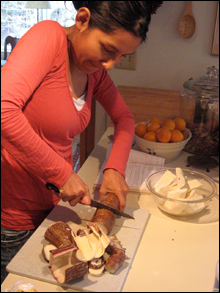
CHOPPING THE TUBER Slicing into the yuca root. |
Standing in front of the chest freezer at my local Latin market (La Bodega Latina, 863 Congress Street), I pull out a plank of frozen banana leaves. The Grinch Glacier avalanches off me instantly: "Yeah! I'm going to Bolivia this afternoon!" I'm just your usual person, tied down to your average life, but I also have a not-so-secret side that somehow gets immigrants to take me on a culinary trip around the world. Thank-you goes out this month to Rommy Holman, a gorgeous, talented, smart Bolivian 20-something, who led this Bolivian teacake adventure.
First we made cuñapes, little airy round breads made out of just three ingredients; they are served traditionally as an afternoon snack. The first ingredient is queso fresco, a white mild cheese that tastes like milk and is dry and crumbly. To that you add this powdery white stuff called manioc or tapioca starch. It looks and feels a lot like cornstarch (squeaky), but it's made out of the yuca root, which supplies non-wheat growing parts of the world (tropical bands of Asia, South America, and Africa) with naturally gluten-free carbs. (Everything here today is gluten-free!) Now you just add a dash of milk and mix into smooth dough. Roll little balls in between your hands, put your thumbprint on the bottom, and bake like cookies. When you bite into the puffed little warm breads, you get a poof of hot air and comforting cheese flavor without any grease! Awesome!
Rommy just got her first driver's license, but the highway is still scary so she couldn't get to La Bodega for the correct ingredients. From a nearby supermarket, she tried Bob's Red Mill tapioca starch, which worked fine, but the grated mozzarella did not. The balls didn't rise. I was alone at home when I tried the queso fresco version, and laughed my ass off once I saw what really happens when you use the right stuff. I'd read online somewhere that cuñape means "woman's breast." That's so like the Internet, right? But my cuñapes — you would not believe — after they deflated slightly as they cooled, looked exactly like a platter of silicone breasts! Handy, bite-sized little snacks. There's just no getting away from sexual innuendo once you get going! I'm sorry I ever mentioned it, except I'm not, because I like eating mini silicone breasts. Seriously! They're so good.
Next up is the humorless but equally delicious pan de arroz en hojas de platano. I like to call this one mashed yuca cakes in banana leaf because the star ingredient is the fresh whole yuca root, that jungle-loving gluten-free tuber I just told you about. You strip the bark-y skin off and put the white flesh (get your brain out of the gutter!) in a pot of water to boil until soft. Drain and mash the flesh into fluffy white crumbles, and knead into them rice flour, queso fresco, salt, sugar, milk, and melted Crisco. Cut the banana leaf with scissors into a dozen rectangles each the size of your hand. Place a flattened cake of dough on each leaf. Fold the corners into the middle, and bake until the cakes are golden and your kitchen smells like a pot of green tea (it's the banana leaves!). Serve with coffee, tea, or hot cocoa.
Lindsay Sterling can be reached atlindsay@lindsaysterling.com. Don't make her travel the world alone! Search "Immigrant Kitchens" on iTunes to get in on the podcast. Recipes and photos are on ImmigrantKitchens.com.